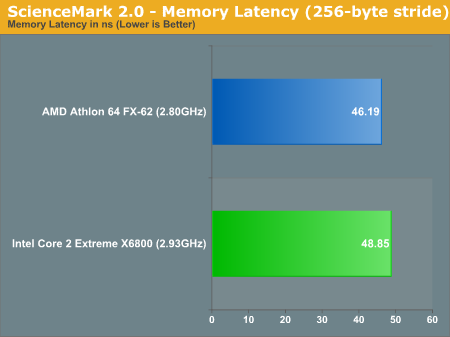
Original Link: https://www.anandtech.com/show/2021
Intel Core 2 Extreme X6800 Preview from Taiwan
by Anand Lal Shimpi & Gary Key on June 6, 2006 7:35 PM EST- Posted in
- CPUs
A few months have passed since our original foray into the world of Conroe, and official naming has been announced for the processor. What we've been calling Conroe is now known as Core 2 Duo, with the Extreme Edition being called Core 2 Extreme. Initial availability of the Core 2 Duo and Core 2 Extreme processors remains unchanged from Intel's original estimates of "early Q3".
At this year's Spring IDF Intel made the unusual move of allowing us and other press to spend some quality time benchmarking its upcoming Conroe processor. Unfortunately we were only allowed to benchmark those games and applications that Intel loaded on the system, and while we did our due diligence on the system configuration we still prefer to benchmark under our own terms.
We're happy to report that we gathered enough parts to build two systems while in Taiwan for Computex. We managed to acquire a Socket-AM2 motherboard equipped with an Athlon 64 FX-62 and a P965 motherboard equipped with a Core 2 Extreme X6800 2.93GHz at our hotel, along with two sets of 2x1GB of DDR2-800 (only 5-5-5-12 modules though), a pair of Hitachi 7K250 SATA hard drives, and two NVIDIA GeForce 7900 GTXes (one for each system) - it helps that all the major players have offices in Taiwan. Of course we happened to pack some power supplies, monitors, keyboards and mice in our carry-on luggage, as well as copies of Windows XP, Quake 4, F.E.A.R., Battlefield 2, SYSMark 2004 and Winstone 2004.
When faced with the choice of testing Conroe or sleeping , we stayed up benchmarking (we'll blame it on the jet lag later). The stage was set: Intel's Core 2 Extreme vs. AMD's recently announced FX-62, and while it's still too early to draw a final verdict we can at least shed more light on how the battle is progressing. Keep in mind that we had a very limited amount of time with the hardware as to not alert anyone that it was missing and being used for things it shouldn't be (not yet at least), so we weren't able to run our full suite of tests. We apologize in advance and promise we'll have more when Conroe launches, but for now enjoy.
The Test
In case we weren't clear: we acquired, built, installed and tested these two test systems entirely on our own and without the help of Intel.
| CPU: | AMD Athlon 64 FX-62 (2.80GHz) Intel Core 2 Extreme X6800 (2.93GHz) |
| Motherboard: | nForce 590-SLI Socket-AM2 Motherboard Intel P965 Motherboard |
| Chipset: | NVIDIA nForce 590 SLI Intel P965 Chipset |
| Chipset Drivers: | nForce 9.34 Beta Intel 7.3.3.1013 |
| Hard Disk: | Hitachi Deskstar T7K250 |
| Memory: | DDR2-800 5-5-5-12 (1GB x 2) |
| Video Card: | NVIDIA GeForce 7900 GTX |
| Video Drivers: | NVIDIA ForceWare 91.28 Beta |
| Desktop Resolution: | 1280 x 1024 - 32-bit @ 60Hz |
| OS: | Windows XP Professional SP2 |
Memory Latency and Bandwidth
We've never been able to look at some of the low level characteristics of Intel's Core architecture, and although we didn't have enough time to do a thorough run of low level benchmarks we were able to run ScienceMark 2.0 in order to get an idea of how the Core 2 Extreme stacked up against the FX-62 in terms of memory latency and bandwidth.
We had seen Conroe performance results that showed the new architecture being able to offer fairly competitive memory access latencies to AMD's architecture, without the need of an on-die memory controller. Our ScienceMark 2.0 results confirm just that:
While AMD still offers lower memory latency, the Core 2 Extreme X6800 is very close in comparison - especially considering that it has no on-die memory controller. With lower clock speeds than its Pentium D siblings and a faster FSB, memory access latency is reduced tremendously with Conroe. On a larger scale, through a very effective cache subsystem as well as memory disambiguation, Conroe can offer significantly improved memory performance compared to its predecessors, including the Athlon 64 X2/FX.
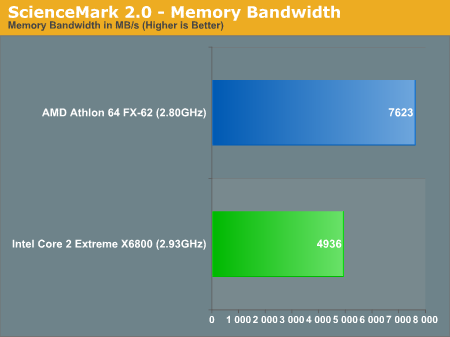
ScienceMark's memory bandwidth results offer a very telling story, showing us the bandwidth limitations of Intel's FSB architecture. While the FX-62's peak theoretical bandwidth is not achieved in real world, you can see how AMD's Direct Connect architecture offers higher limits for chip-to-chip communication.
Business Application Performance
We start off with Business Winstone 2004, a benchmark that has since been discontinued by VeriTest but one we continue to use because of the relevance of its results. Business Winstone doesn't generally vary all that much with CPU speed as the benchmark itself is quite I/O heavy. As you can see below, this doesn't stop the Core 2 Extreme X6800 from maintaining a healthy lead over the FX-62:

With a 17.5% performance advantage, the Core 2 Extreme starts off by performing very well in an area where the Pentium 4 could not: general business applications. The Pentium D would not only offer mediocre performance here, but also produce a lot of heat while doing it; Intel's Core architecture is a very different beast and the results here show it.
We turned to SYSMark 2004's Office Productivity suite for another look at office application performance, and the results were no less impressive:
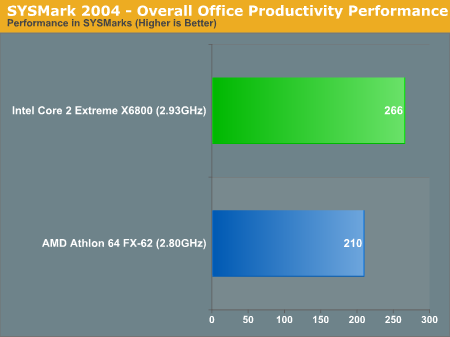
Overall Office Productivity performance with the Core 2 Extreme X6800 is just over 26% faster than the identically configured FX-62. The breakdown of the OP suite is below, as you can see some individual tests are closer than others:

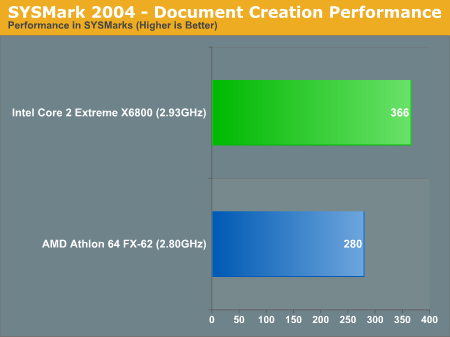
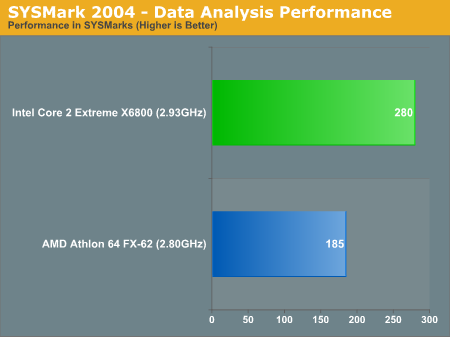
The Communication tests in particular are very close, but there's a strong possibility that is because of the I/O bound nature of those benchmarks. The Communication suite was great at showcasing hard disk performance, so it's not a surprise that it barely shows any performance difference between the two CPUs.
Content Creation Performance
We were a bit surprised by the close race in the Multimedia Content Creation Winstone tests, but it does look like the Athlon 64 FX-62 can still be pretty competitive in some areas:
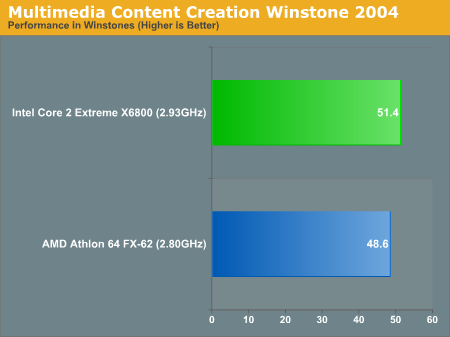
The Core 2 Extreme X6800 is still faster by 5.7%, but no where near the huge performance increases we saw on the previous page. Looking at SYSMark's ICC tests however, the picture changes dramatically:
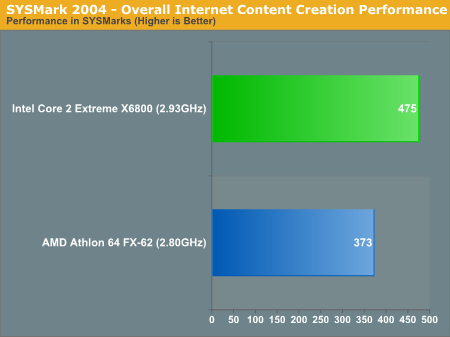
When AMD introduced the Athlon 64 X2 we saw SYSMark 2004 scores hit new, never before seen, highs.
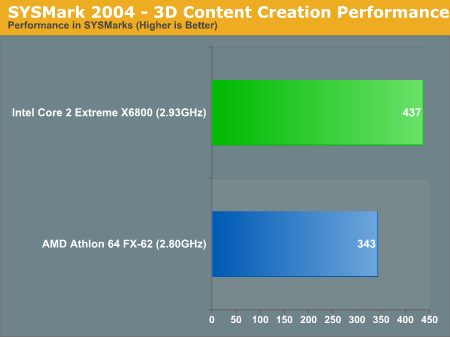
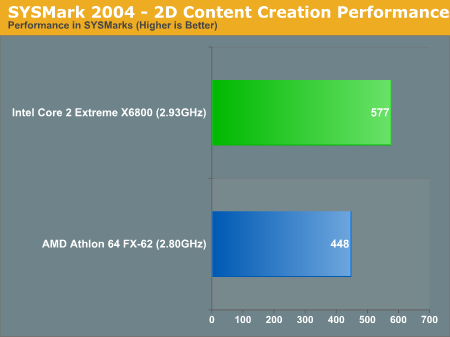
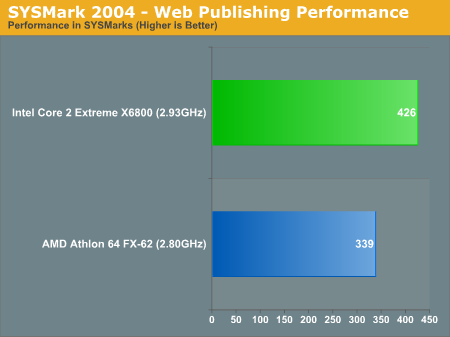
With Intel's Core 2 Extreme X6800, our performance expectations are reset once more. In all of the Content Creation tests, the Core 2 Extreme outpaces the FX-62 by anywhere from 27% to 28%.
Gaming Performance
Next up was gaming performance, and of course using our own game demos. We tested everything at 1024 x 768 since we only had a single 7900 GTX per system at our disposal.
We already knew to expect solid Quake 4 performance out of Intel's Core architecture, and the Core 2 Extreme X6800 does not fail us - offering just under 24% better performance than the FX-62.
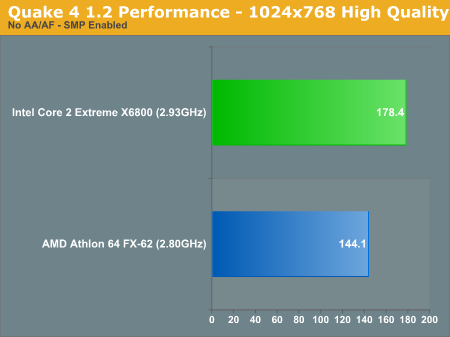
We've also already seen Conroe's performance under F.E.A.R., and with the latest 1.05 patch performance is in line with our expectations:
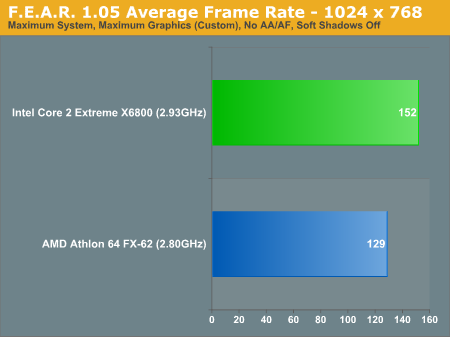
Core 2 Extreme boasts a 17.8% performance advantage over the FX-62 in average frame rate.
The minimum frame rate is significantly higher at 50.9%, and even after multiple runs the performance advantage was consistent:
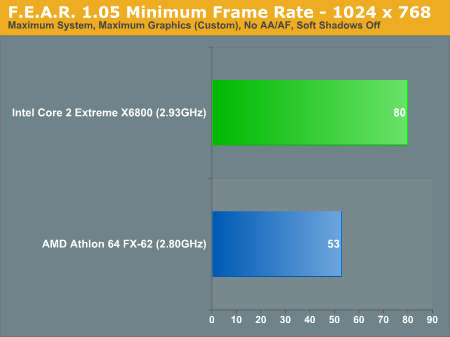
Finally the Core 2 Extreme system was able to boast a 14.2% higher maximum frame rate under F.E.A.R.
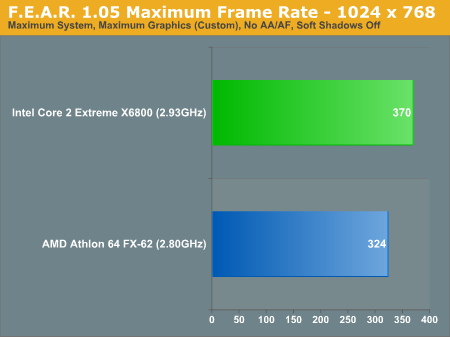
Our final gaming benchmark during our short but sweet testing period with the Core 2 Extreme was Battlefield 2, and its performance was in line with what we've seen in the previous two titles:
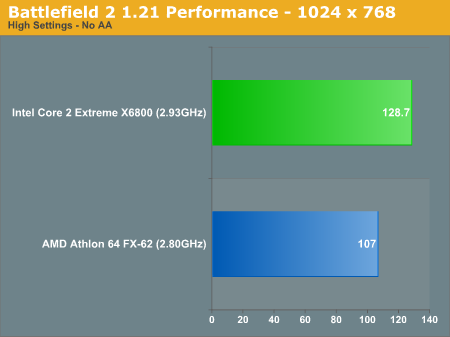
Intel's holding on to a 20.3% performance advantage under Battlefield 2.
We're still wary of crowning Intel the new gaming performance champion, especially without having run other very important titles such as Oblivion and Half Life 2: Episode 1, but until we can things are definitely looking extremely promising for the Core architecture.
Final Words: Conroe Availability and Pricing
While Intel's Core 2 Duo and Core 2 Extreme processors will be released at the beginning of Q3 of this year it will take some time for all of Intel's shipments to be Conroe based. The scary statistic is that by the end of this year, only 25% of Intel's Performance Mainstream desktop processor shipments will be based on Conroe. The remaining 75% will still be NetBurst based, meaning they will be Pentium 4, Pentium D and Pentium Extreme Edition.
Given how competitive Core 2 Extreme is with the Athlon 64 FX-62, you would expect no one to want to purchase a NetBurst based processor if they can get a Core 2 Duo or Core 2 Extreme for a competitive price. Intel does have a plan to deal with the over availability of undesirable Pentium Ds and limited supply of Conroes; Intel would do what anyone would do if you're trying to move a lot of undesirable product: cut the price.
By the time Conroe ships, Intel's Conroe and Pentium D pricing will be as follows:
| CPU | Price |
| Intel Core 2 Extreme X6800 (2.93GHz/4M) | $999 |
| Intel Pentium Extreme Edition 965 (3.73GHz/2Mx2) | $999 |
| Intel Core 2 Duo E6700 (2.67GHz/4M) | $530 |
| Intel Core 2 Duo E6600 (2.40GHz/4M) | $316 |
| Intel Pentium D 960 (3.60GHz/2Mx2) | $316 |
| Intel Core 2 Duo E6400 (2.13GHz/2M) | $224 |
| Intel Pentium D 950 (3.40GHz/2Mx2) | $224 |
| Intel Core 2 Duo E6300 (1.86GHz/2M) | $183 |
| Intel Pentium D 940 (3.20GHz/2Mx2) | $183 |
| Intel Pentium D 930 (3.00GHz/2Mx2) | $178 |
| Intel Pentium D 920 (2.80GHz/2Mx2) | $178 |
| Intel Pentium D 820 (2.80GHz/1Mx2) | $133 |
| Intel Pentium D 805 (2.66GHz/1Mx2) | $93 |
While the Pentium D has never been as attractive as AMD's Athlon 64 X2, at these prices some of them may be difficult to resist. The $93 Pentium D 805 will be particularly hard to ignore, when was the last time you could build a solid two processor workstation for a few hundred dollars?
The Pentium D 805 aside, the rest of the Pentium D line becomes extremely attractive after these price cuts take place, especially when you consider that AMD's cheapest dual core offering is still hovering around the $300 mark.
Intel's price cuts are very aggressive, to the point that they are the talk of the town in Taiwan. Every single motherboard manufacturer we met with asked us about Intel's price cuts and, more importantly, how AMD would respond. We've been told that AMD will respond with a series of price cuts of its own, the questions when and how much remain unanswered. Next week, in Taipei, AMD will be speaking with many motherboard manufacturers about its response to Intel's threat.
Despite the lower pricing on the Pentium Ds, it's not like Conroe ends up being all that expensive. The entry level E6300 and E6400 chips are both priced at $183 and $224, respectively, which is far from high. As attractive as the Pentium D's pricing may be, Conroe's performance and lower power consumption may still end up driving more demand than there is supply.
For the Dells of the world, Conroe availability shouldn't be too much of an issue because companies like Dell get first dibs. For years of not going with AMD, all while demanding something more competitive from Intel, you better believe that Dell is going to soak up every last Conroe that it can.
The problem then becomes what happens after Dell and HP have eaten their lunch, unfortunately the concern is that aggressive pricing won't be enough to reduce retail demand for Conroe. What we're worried about happening is a very small supply of Conroes on the retail market in late Q3/early Q4, resulting in much higher street prices than what you see in the table above. In the worst case scenario for Intel, Conroe's limited retail availability could result in a price to performance ratio equal to or worse than AMD's Athlon 64 X2.
The benchmarks we've seen show Conroe as a very strong competitor to the Athlon 64 X2, availability could be what limits how much lost ground Intel can regain before AMD has a chance to respond with K8L.
While performance here is extremely strong, we also haven't even touched on the overclockability of Conroe; from what we've seen, hitting above 3.5GHz on the highest end parts isn't too far fetched on air cooling alone. The absolute highest we've seen on air is 3.8GHz from a Core 2 Extreme X6800 processor. By the time Conroe officially launches, we'll be able to provide a full set of performance tests but so far we're seeing even more data to support the idea that Intel really has a winner on its hands.

